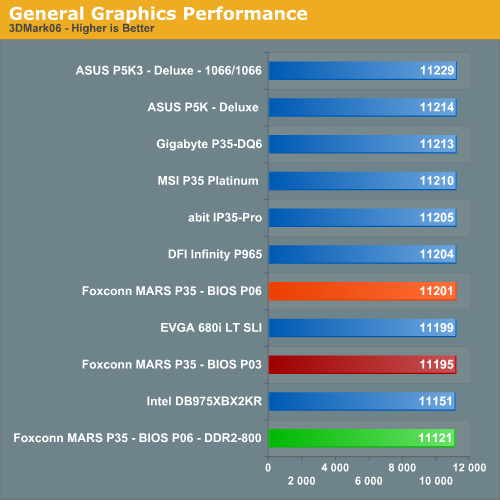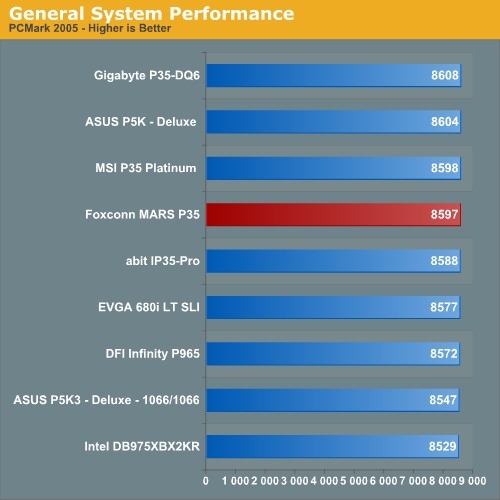Foxconn MARS: God of War Performance?
by Gary Key on September 21, 2007 12:00 PM EST- Posted in
- Motherboards
Synthetic Graphics Performance
The 3DMark series of benchmarks developed and provided by Futuremark are among the most widely used tools for benchmark reporting and comparisons. Although the benchmarks are very useful for providing apple to apple comparisons across a broad array of GPU and CPU configurations they are not a substitute for actual application and gaming benchmarks. In this sense we consider the 3DMark benchmarks to be purely synthetic in nature but still valuable for providing consistent measurements of performance.


In our 3DMark06 test, all of the boards are within 1% of each other. When looking at the individual tests, the Foxconn board scores slightly better in the CPU tests but is second to last in the the SM2.0 and SM3.0 tests.
In the more memory and CPU throughput sensitive 3DMark01 benchmark we see the spread between boards is way under 1%. The Foxconn board scores near the top in each category except the Nature Test where it's just barely ahead of the 975X board.
General System Performance
The PCMark05 benchmark developed and provided by Futuremark is designed to measure overall system performance for the typical home computing user. This tool provides both system and component level benchmarking results utilizing subsets of real world applications or programs. This benchmark is useful for providing comparative results across a broad array of Graphics, CPU, Hard Disk, and Memory configurations along with multithreading results. In this sense we consider the PCMark benchmark to be both synthetic and real world in nature and it again provides consistency in our benchmark results.

Once again, all of the boards are basically within shouting range of each other with the Foxconn board finishing near the top of the pack. The MARS board does very well in the Hard Disk and CPU sections while falling towards the rear of the pack in the graphics test.
The 3DMark series of benchmarks developed and provided by Futuremark are among the most widely used tools for benchmark reporting and comparisons. Although the benchmarks are very useful for providing apple to apple comparisons across a broad array of GPU and CPU configurations they are not a substitute for actual application and gaming benchmarks. In this sense we consider the 3DMark benchmarks to be purely synthetic in nature but still valuable for providing consistent measurements of performance.


In our 3DMark06 test, all of the boards are within 1% of each other. When looking at the individual tests, the Foxconn board scores slightly better in the CPU tests but is second to last in the the SM2.0 and SM3.0 tests.
In the more memory and CPU throughput sensitive 3DMark01 benchmark we see the spread between boards is way under 1%. The Foxconn board scores near the top in each category except the Nature Test where it's just barely ahead of the 975X board.
General System Performance
The PCMark05 benchmark developed and provided by Futuremark is designed to measure overall system performance for the typical home computing user. This tool provides both system and component level benchmarking results utilizing subsets of real world applications or programs. This benchmark is useful for providing comparative results across a broad array of Graphics, CPU, Hard Disk, and Memory configurations along with multithreading results. In this sense we consider the PCMark benchmark to be both synthetic and real world in nature and it again provides consistency in our benchmark results.

Once again, all of the boards are basically within shouting range of each other with the Foxconn board finishing near the top of the pack. The MARS board does very well in the Hard Disk and CPU sections while falling towards the rear of the pack in the graphics test.










17 Comments
View All Comments
Tujan - Tuesday, October 2, 2007 - link
You used a 1000Watt PSU on this review. Do you think that it would be possible to post the load,and non-loaded power stats for these boards.?My thinking is that a person could get by with 600 watts w/o a overclocker profile. Yet I do not know. The PSU suppliers are making larger,and larger power supplies. Yet (at least for me) I do not see that my peripheral count is actually going to be larger. And w/o overclocking the CPUs actually do not require higher wattage values.As a specification at retail.
[ ]Could a person get by on the set with this review on only changing the PSU to 600,or 750 Max PSU ?
And what is the boards load values ? Wich boards are better.Seems that with the several layer curcuit boards the power requirement would be less,not more .[though I know the video cards are really eating the power up-they have their limit'].
Thanks good article.Nice board Foxcon.
mostlyprudent - Monday, September 24, 2007 - link
I always enjoy motherboard reviews, BUT did I miss the long awaited P35 roundup? If it's still in the works, why the single board review?Etern205 - Sunday, September 23, 2007 - link
In your test setup it says you guys used 2x2048 Corsair rammodules which equals to 4GB, but in those cpu-z screen shots
it only show 2GB instead of 4. Is that right? Shouldn't it show
4GB instead of 2?
And the images do now work when users try to enlarge them.
All I get is a server error.
Thank you.
wwswimming - Sunday, September 23, 2007 - link
Foxconn has a boatload of experience manufacturingmotherboards. up till now i've thought of them
partially in terms of their "cheap specials at
Fry's", kind of like ECS, where they sell the
board-CPU combo for the price of the CPU.
BUT i learned something new, 8 x 435 was it, 3.2
+ .24 + .040, (is my math right ?), 3.48 GHz for
the Q6600.
that plus the clean layout ... i like the
North Bridge South Bridge heat sink design.
plain old aluminum heat sinks work real well
if you get enough inlet air to them, which is
not hard to do. one heat pipe. not over-designed.
Lord Evermore - Sunday, September 23, 2007 - link
No mainboard costing 200 dollars can be called "budget". Under 75 is budget level. I hate having to even go to 125 to get a full-featured board instead of the exact same board costing 30 less but which is missing one crucial feature. Over 150, I want ALL the trimmings, and none of that "disables the x1 slots if you use Crossfire" crap. WTF is that?Mainboards are too damned expensive these days.
emilyek - Saturday, September 22, 2007 - link
Before this review, I had a pretty good idea where this board would fall in terms of performance. I've seen FOXCONN products here and elsewhere before.It made me want to ask: "Why are some motherboards better performers than others?" I mean, they use the same chipsets, right?
What, specifically, is the reason that one company consistently falls a few paces behind others? It is board layout? Type of components used?
Someone enlighten me.
JarredWalton - Saturday, September 22, 2007 - link
Board layout can impact things a bit, but mostly it's the BIOS and tuning - or lack thereof.lopri - Saturday, September 22, 2007 - link
I noticed for this review that 2GB DIMMs were employed for total 4GB system memory, and there was no mention of overclocking/stability when all 4 DIMM slots were filled. I do not know whether the compared boards from other vendors were also equipped with 2x2GB DIMMs, but it does raise a few questions.1. From my experience (which means it may not be generalized), when memory capacity isn't a factor, 2GB sticks tend to show better performance than 1GB sticks if same number of slots are occupied. (all others being equal) I don't have an exact understanding on this but if this is indeed a case and other boards were tested with 4x1GB configuration, the performance results (especially synthetic ones) could be kinda skewed?
2. Was the board able to maintain the same overclock/stability when all 4 slots were occupied? Again, from my experience Intel desktop MCHs (or maybe it's the boards/BIOSes) left quite a bit to be desired. I would like a little more detailed comments on this front.
Excellent review as always. Thanks.
lopri - Saturday, September 22, 2007 - link
Oh and also there is the factor of interleaving when comparing 2 slots vs 4 slots. I do not know how much but I would think it matters when the performance varies by like 1% among different boards.yyrkoon - Saturday, September 22, 2007 - link
I see they also implemented the Northbridge<->PWM section cooling with heatpipes. Recipe for hot PWM with an Overclocked 4 core CPU . . . and what the hell is up with all these hokey heatsink designs these companies are comming up with ? The BIOS monitoring application looks like something you would see on a 5 year olds lunch box as well.I would be more impressed if these companies would work on something functional, and quite this 'bling bling' look that makes their products look tacky. The ethernet performance is fairly impressive, but for this cost, with the stupid looking application/hokey heatsinks, and the fact that they cannot seem to get it into their heads that putting the PWM section, and the northbridge on the same heatpipe loop is not a good thing, I would not even consider this board.
Another gripe is the JM eSATA port. IF they *need* to include an eSATA port, why not put in something that can actually fully supports FIS Port multiplier technology ?
Anyhow, aside from the GbE performance, I think this board is a loser . . .